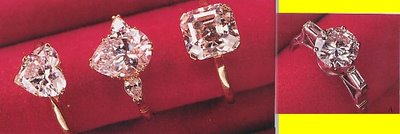
The Gift of LOVE...
...20th Century.
".... the first yellow beam of the sun struck through the innumerable prism of an immense and exquisitely chiselled diamond - and a white radiance was kindled."
When Scott Fitzgerald wrote 'The Diamond As Big As The Ritz', he had no lack of inspiration. For his century, this century, is the one in which the diamond reached its full potential. Modern cutting and polishing techniques were able to release the full beauty of a stone so that white light radiated like a beacon from each of its facets. Modern materials liberated the diamond from old-style settings, opening up fresh new vista for 20th century craftsmen.
Around 1900, platinum was universally adopted. With its brilliant untarnishable whiteness, its durability and strentgh, platinum, has been dubbed the 'metal of Heaven'. With the unique resources of platinum to hand, the jeweller was able to reduce the ring setting dramatically. The design concerntrated more and more on the stone; the setting was reduced to a skeletal frame; decorative metaphors became secondary. The diamond itself was all the symbolism required.
Cuts became monuments of mathematical perfection: emerald, square, rectangular, pear and navette; set as solitaires, or in clusters. For the modern millionairess, a large solitaire - either coloured or white, or a colouerd diamond between two white stone - would be the fashionable choice.
"Square-cut or pear-shape, These rocks don't lose their shape" .... diamonds have always been girl's best friend.
When the Round Brilliant shape cerished fame - the discovery of new materials, such as platinum, combined with more sophisticated diamond cutting techniques have opened up new vistas for diamonds and the 20th century craftsmen. Reducing the setting to a skeletal fram allows the light to reach every ones of the diamond's 58 facets, producing the maximum fire and brilliance. In about 1890 Tiffany's of New York developed this universal setting. The large centre stone with baguette diamond shoulders has become a 20th century classic.
Along with the fame by the round brilliant cut, cherished fame in the 20th century the diamond polisher has found the perfect mathematical propotions for producing stones of dazzling fire and brilliance. A classic round brilliant stone will have 58 facets, each onr polished by hand.
This classic cut has been adapted to give us even more in choice in the shape of our diamonds - heart, pear, marquise and princess cuts, to mention but a few, all sparkle with polished precision.
The above illustrate, the glorious rings for today's bride, Around brilliant solitaire with baguette shoulders, A solitaire heart, a large pear with further pear cut diamonds on each shoulder, and a square-shaped stone with a princess cut.
Tempting designs appeared in the catalogues and advertisments of all the great house; Harry Winston, the American jeweller; Tiffany; Boucheron; Cartier - first with baguette-cut diamonds in geometric outline. These and others made rich use of modern materials and techniques.
The imaginative skills of 20th century designers continue to delight lovers with exquisite new ways of presenting these romantic stones. As recently as 1981, the German manufacturer Niessing invented the platinum tension set ring; here the diamond is poised, magically suspended as it were, between the two halves of the hoop.
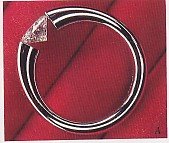 Niessing and the Platinum Tension setting in April 1981, Niessing, in Germany, invented a brilliant new method of revealing the diamond in all its glory. Platinum has the unique ability of holding incredible tensions and the stone is literally suspended in a slit in the shank anfd held in the platinum's vice-like grip.
Niessing and the Platinum Tension setting in April 1981, Niessing, in Germany, invented a brilliant new method of revealing the diamond in all its glory. Platinum has the unique ability of holding incredible tensions and the stone is literally suspended in a slit in the shank anfd held in the platinum's vice-like grip.
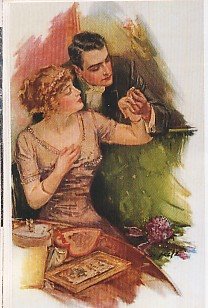
 Niessing and the Platinum Tension setting in April 1981, Niessing, in Germany, invented a brilliant new method of revealing the diamond in all its glory. Platinum has the unique ability of holding incredible tensions and the stone is literally suspended in a slit in the shank anfd held in the platinum's vice-like grip.
Niessing and the Platinum Tension setting in April 1981, Niessing, in Germany, invented a brilliant new method of revealing the diamond in all its glory. Platinum has the unique ability of holding incredible tensions and the stone is literally suspended in a slit in the shank anfd held in the platinum's vice-like grip.
The Queen Victoria was not the only monarch to be presented with an historic diamond. In 1905 the Cullinan was discovered. Twice the size of any diamond yet found, this remarkable stone was handed, in its rough form, to king Edward VII, who took a great personal interest in the cutting of the Cullinan. This heart-stopping feat was performed by Joseph Asscher in Amsterdam on 10th February, 1908 at 2.45 p.m. precisely. The poor man fainted at 2.46 - as the cleaving blade broke. The 9 major stones cut from the Cullinan are part of the Royal Collection today. The third and the fourth largest stones are often worn by Queen as a brooch and are called, affectionately, "Granny's chips".
The present Queen has the loveliest of diamond betrothal rings. This ring was personally designed for her by Prince Philip. Theheirloom stones came from her mother, Princess Andrew of Greece. The platinum ring is set with eleven diamonds, a central solitaire of three carats, and five smaller stones on each shoulders.
Nancy Mitford once observed that, "the diamond is a stone possessed for the female mind, however unsophisicated, of curious psychological attributes", and she compared its magic with a love potion. Even in the modern world, the love potion of diamonds continues to work its magic for all.
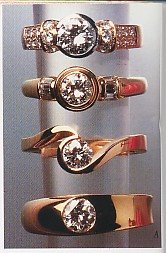 The fashionable solitaire has now become the most popular pledge of marriage. Diamonds are no longer only for royalty or the very rich. They have now become more accessible as an everlasting promise of love.
The fashionable solitaire has now become the most popular pledge of marriage. Diamonds are no longer only for royalty or the very rich. They have now become more accessible as an everlasting promise of love.
Whatever the flux and flow of jewellery fashion, the diamond engagement ring is still, unassailably, the most desired sign of love for the 20th century bride.... "Ryches be unstabl And beauty will dekay, But faithful love will ever last Till daeth dryve it away."
Despite today's modern scepticism over the magical powers of precious stones, the diamond - intrinsically the greatest and most beautiful of gems - will always be, in its shining of the union of two people in love.
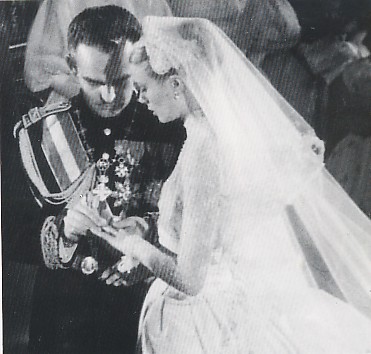
Grace Kelly - Only five days after meeting Prince Rainier for the second time Grace Kelly confessed to her mother that she was ' very much in love'. He presented her with a 12 carat emerald-cut diamond solitaire and a few months later their fairytale romance was sealed by a civil marriage. The following day there was a full nuptial mass held in the Catherdral in Monacco.
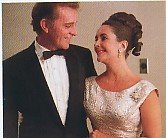 Elizabeth Taylor - The Name of Elizabeth Taylor has become synonymous with diamonds. Many of them were bought for her by Richard Burton during their long and eventful romance.
Elizabeth Taylor - The Name of Elizabeth Taylor has become synonymous with diamonds. Many of them were bought for her by Richard Burton during their long and eventful romance.
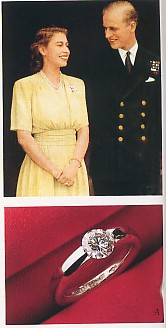
Queen Elizabeth II - Princess Elizabeth arrived at Westminister Abbey looking like a "Fairy Queen". The glamour and romance of her wedding was like a ray of sunshine after the war.
She was given many beautiful diamonds when she married but most precious must have been her engagement ring.
A large solitaire diamond supported by diamond shoulders was made with heirloom stones from a tiara of Prince Philip's mother. The remaining stones were transformed into a bracelet.
The above ring - for 20th century engagement rings the symbolism in the design of the mount has largely disappeared. All the romantic associations are now represented in th stone; the diamond itself has now become the ultimate symbol of LOVE....
Nancy Mitford once observed that, "the diamond is a stone possessed for the female mind, however unsophisicated, of curious psychological attributes", and she compared its magic with a love potion. Even in the modern world, the love potion of diamonds continues to work its magic for all.
 The fashionable solitaire has now become the most popular pledge of marriage. Diamonds are no longer only for royalty or the very rich. They have now become more accessible as an everlasting promise of love.
The fashionable solitaire has now become the most popular pledge of marriage. Diamonds are no longer only for royalty or the very rich. They have now become more accessible as an everlasting promise of love.Whatever the flux and flow of jewellery fashion, the diamond engagement ring is still, unassailably, the most desired sign of love for the 20th century bride.... "Ryches be unstabl And beauty will dekay, But faithful love will ever last Till daeth dryve it away."
Despite today's modern scepticism over the magical powers of precious stones, the diamond - intrinsically the greatest and most beautiful of gems - will always be, in its shining of the union of two people in love.

Grace Kelly - Only five days after meeting Prince Rainier for the second time Grace Kelly confessed to her mother that she was ' very much in love'. He presented her with a 12 carat emerald-cut diamond solitaire and a few months later their fairytale romance was sealed by a civil marriage. The following day there was a full nuptial mass held in the Catherdral in Monacco.
 Elizabeth Taylor - The Name of Elizabeth Taylor has become synonymous with diamonds. Many of them were bought for her by Richard Burton during their long and eventful romance.
Elizabeth Taylor - The Name of Elizabeth Taylor has become synonymous with diamonds. Many of them were bought for her by Richard Burton during their long and eventful romance.
Queen Elizabeth II - Princess Elizabeth arrived at Westminister Abbey looking like a "Fairy Queen". The glamour and romance of her wedding was like a ray of sunshine after the war.
She was given many beautiful diamonds when she married but most precious must have been her engagement ring.
A large solitaire diamond supported by diamond shoulders was made with heirloom stones from a tiara of Prince Philip's mother. The remaining stones were transformed into a bracelet.
The above ring - for 20th century engagement rings the symbolism in the design of the mount has largely disappeared. All the romantic associations are now represented in th stone; the diamond itself has now become the ultimate symbol of LOVE....


0 Comments:
Post a Comment
<< Home